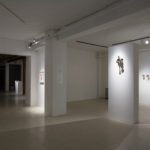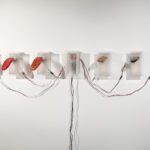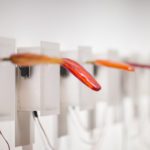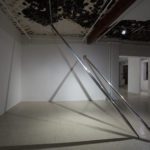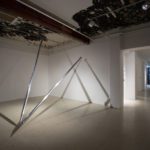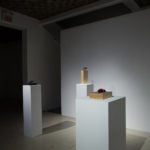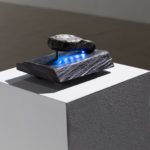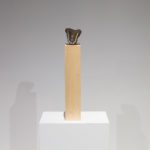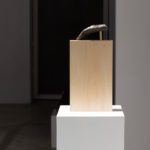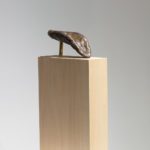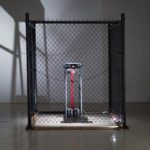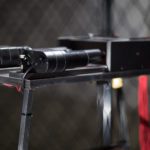Opening reception: Thursday, November 9, 2017 from 5-8 p.m.
Ingrid Bachmann: Angry Work
Art Mûr, Montreal (QC)
Text by Nancy Webb
In Acts 2:3 of the Bible, flaming tongues lap at the disciples, conferring upon them the ability to speak languages not their own. These fiery tongues have signified the power of speech, persuasion and the ability to preach to the masses. Ingrid Bachmann’s tongues in Pinocchio’s Dilemma are glossy as if sugarcoated and boiled into hard candies—a crystallization process. They are the only of her works that people have tried to lick. Alternately seductive and repulsive, they wag mechanically at eye-level, emitting a small wind-up machine language of their own.
The tongue gives the impression of an attempt to tell, a revealing of secrets. On the opposing side of the room, a rod extends slowly from a hole in the wall, inching out, then back in. Pinocchio’s nose is an instantly recognizable stand-in for lies, liars, fakes. Pinocchio originated as the protagonist of a 19th-century children’s book by the Italian writer Carlo Collodi, and was most famously adapted by The Walt Disney Company. The pre-Disney Pinocchio is unruly, violent and mischievous; his story was originally intended to be a tragedy in which the marionette is hung from an oak tree branch by his enemies.
Angry Work contains a latent violence—that which is found in childhood games, stories, myths, novels and in the tools of the everyday. Two 14-foot-long knitting needles—domestic weaponry—lean as dead as stones, cool and silent, against the wall. These weighted objects commune with three bronze tongues, pre-vocalizations, embalmed. Bronze is a silent material.
Two drawings invoke Cassandra, who was promised the gift of prophecy by Apollo. When Apollo appeared to her, she refused his sexual advances. In some iterations of the story, Apollo appeared as a wolf surrounded by mice and spat on her tongue. She awoke with a taste on her tongue. Maybe metallic, maybe red. She had been granted the gift of prophecy, with one condition: no one would believe her. This burdened us with one of the earliest models of hysteria—speaking in tongues, speaking marred truths. Bachmann maintains that Angry Work is not limited to women’s anger, or to personal anger. It’s about generalized anger.
“The red world And corresponding red breezes.”1
A cloud of anger, hints of red. An amorphous unknown. “The Airborne Toxic Event”2 that encapsulates truth, lies, histories repeated, struggle, strife, shock, grappling and anger, anger, anger.
I am told that The Angry Machine weighs 400 pounds and emits a mechanized hum. It will be fenced in, for the protection of both viewers and itself. It will not perform on demand, but at scheduled intervals, only occasionally. It has a projectile that is red. Red is the memory of a children’s game, trying to avoid hitting yourself, to avoid the smack of something against your skin. Red is interiority: the tongue, cheeks, throat and kisses. One can “see red” in a fit of rage. Red is blood, and red is romance — “roses being burned alive.”3
1. Anne Carson, Autobiography of Red: A Novel in Verse (Toronto: Vintage Canada, 1999), 14.
2. Don DeLillo, White Noise (New York: Viking, 1985).
3. Carson, Autobiography of Red, 12.





